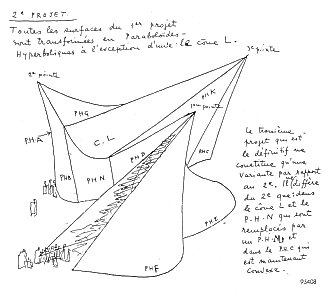
| Conoids and Hyperbolic Paraboloids in Le Corbusier's Philips Pavilion |
|---|
Laboratorio Multimediale di Architettura
Università di Roma "La Sapienza"
Via Antonio Gramsci, 53 - 00197 Rome, Italy
The Philips Pavilion at the Brussels World Fair is the first of Le Corbusier's architectural works to connect the evolution of his mathematical thought on harmonic series and modular coordination with the idea of three-dimensional continuity. This propitious circumstance was the consequece of his collaboration with Iannis Xenakis, the famous contemporary musician working at that time as engineer in Rue de Sèvres. Xenakis' very deep interest in mathematical structures was improved on his becaming acquainted with the Modulor, while at the same time Le Corbusier encountered double ruled quadric surfaces.
 At the beginning
of 1956, Louis Kalff, the art director of Philips industries,
proposed to Le Corbusier a new kind of participation in the World's
Fair: their intension was not to expose their products, but rather
they wanted a bold show of sound and light effects, to illustrate
what Philips' technical progress was able to lead to. "I
won't design a pavilion with façades, I'll give to you
a Poème Électronic and the bottle containing
it!", answered Le Corbusier. He designed a building that
represented a real synthesis of arts: coloured lights, contemporary
music, the projection of enormous warped images in a space without
architectonical quality. It could be, at the minimum, even a
scaffold.
At the beginning
of 1956, Louis Kalff, the art director of Philips industries,
proposed to Le Corbusier a new kind of participation in the World's
Fair: their intension was not to expose their products, but rather
they wanted a bold show of sound and light effects, to illustrate
what Philips' technical progress was able to lead to. "I
won't design a pavilion with façades, I'll give to you
a Poème Électronic and the bottle containing
it!", answered Le Corbusier. He designed a building that
represented a real synthesis of arts: coloured lights, contemporary
music, the projection of enormous warped images in a space without
architectonical quality. It could be, at the minimum, even a
scaffold.
The idea of a container without an aesthetic claim allowed Le Corbusier to think only about the show; in the meantime he entrusted Xenakis with a "mathematical translation" of his sketches, which represented the volume of a rounded bottle with a stomach-shaped plan.
In the Poème Électronic the correspondence between music and architecture is not only a matter of geometry. It was projected by Le Corbusier as if it were an orchestral work in which lights, loudspeakers, film projections on curved surfaces, spectators' shadows and their expression of wonder, objects hanging from the ceiling and the containing space itself were all virtual instruments. Architecture played, at the same time, the role of orchestral instrument and of sound box, container and contents.
ILLUSTRATION: Sketch by Iannis Xenakis for the second design for the Philips Pavilion for the World's Fair, Brussels, 1956.
ABOUT THE AUTHOR
Alessandra
Capanna is an Italian Architect
living and working in Rome. She has taken her degree in Architecture
at University of Rome 'La Sapienza', from which she also received
her Ph.D, discussing a thesis entitled "Strutture Matematiche
della Composizione", concerning the logical paradigms in
music and in architecture. She is the author of Le Corbusier.
Padiglione Philips, Bruxelles (Universale di Architettura
67, January 2000), on the correspondence between the geometry
of hyperbolic paraboloids and technical and acoustic needs, and
its final and aesthetics consequences. Among her published articles
on mathematical principles both in music and in architecture
are "Una struttura matematica della composizione",
remarking the idea of self-similarity in composition; "Musica
e Architettura. Tra ispirazione e metodo", about three architectures
by Steven Holl, Peter Cook and Daniel Libeskind; and "Iannis
Xenakis. Combinazioni compositive senza limiti", taken from
a lecture given at the Dipartimento di Progettazione Architettonica
e Urbana at the University of Rome.
|
Alessandra Capanna, "Conoids and Hyperbolic Paraboloids in Le Corbusier's Philips Pavilion", pp. 35-44 in Nexus III: Architecture and Mathematics, ed. Kim Williams, Pisa: Pacini Editore, 2000. http://www.nexusjournal.com/conferences/N2000-Capanna.html |
|
|
|
|
